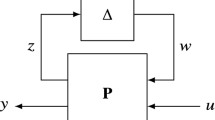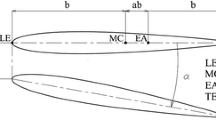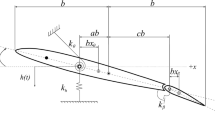Abstract
Analytical expressions for the derivatives of structural dynamics and control design criteria, with respect to structural and control design variables are extended to deal with residualized aeroservoelastic models. The mathematical model considered is a first-order time domain feedback system subject to model size reduction by means of dynamic residualization. The structure is represented by a number of structural vibration modes and the aerodynamics by minimum-state rational approximation functions. The MIMO control system couples control surface motion to the response of motion sensors located on the structure. In the optimum design process for aeroservoelastic systems, considerable computation time is spent on calculating the derivatives that define the sensitivity to design changes. The extended formulation and new techniques of this work make their calculation more efficient and further enhance multidisciplinary on-line studies. A realistic numerical example of the optimal design of an aeroservoelastic system comprising a carbon-composite wing with four control surfaces is used to assess the performance of this method.
Similar content being viewed by others
References
Abel, I.; Newsom, J.R.; Dunn, H.J. 1977: Application of two synthetic methods for active flutter suppression of an aeroelastic wind-tunnel model.AIAA Atm. Flight Mech. Conf., pp. 93–103
Adams, W.M., Jr.; Tiffany, S.H.; Newsom, J.R.; Peele, E.L. 1984: STABCAR — A program for finding characteristic roots of systems having transcedental stability matrices,NASA-TP 2165
Bisplinghoff, R.L.; Ashley, H. 1962:Principles of aeroelasticity. New York: Wiley
Fox, R.J.; Kapoor, M.P. 1968: Rate of change of eigenvalues and eigenvectors.AIAA J. 6, 2426–2429
Karpel, M. 1990a: Time-domain modelling using weighted unsteady aerodynamic forces.J. Guid. Control & Dyn. 13, 30–37
Karpel, M. 1990b: Sensitivity derivatives of flutter characteristics and stability margins for aeroservoelastic design.J. Aircraft 27, 368–375
Karpel, M. 1990c: Reduced order aeroelastic models via dynamic residualization.J. Aircraft 27, 449–455
Karpel, M. 1992: Multidisciplinary optimization of aeroservoelastic systems using reduced size models.J. Aircraft 29, 939–946
Karpel, M.; Brainin, L. 1995: Stress considerations in reduced-size aeroelastic optimization.AIAA J. 33, 716–722
Mukhopadhyay, V.; Newsom, J.R.; Able, I. 1981: A method for obtaining reduced-order control laws for high-order systems using optimisation techniques.NASA-TP-1876
Rudisill, C.R.; Bhatia, K.G. 1971: Optimization of complex structures to satisfy flutter requirements.AIAA J. 9, 1487–1491
Tiffany, S.H.; Adams, W.M., Jr. 1988: Nonlinear programming extension to rational approximation methods of unsteady aerodynamic forces.NASA-TP-2776
Wilkinson, K.; Lerner, E.; Taylor, R.F. 1976: Practical design of minimum-weight aircraft structures for strength and flutter requirements.J. Aircraft 13, 614–624
Zole, A.; Karpel, M. 1994: Continuous gust response and sensitivity derivatives using state-space models.J. Aircraft 31, 1212–1214
Author information
Authors and Affiliations
Rights and permissions
About this article
Cite this article
Herszberg, I., Karpel, M. Flutter sensitivity analysis using residualization for actively controlled flight vehicles. Structural Optimization 12, 229–236 (1996). https://doi.org/10.1007/BF01197361
Received:
Issue Date:
DOI: https://doi.org/10.1007/BF01197361




